Stephanie A. Mann's Blog, page 260
September 10, 2013
The Siege of Drogheda, September 11, 1649
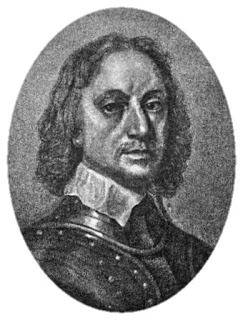 "I am persuaded that this is a righteous judgement of God on these barbarous wretches, who have imbrued their hands with so much innocent blood; and that it will tend to prevent the effusion of blood for the future, which are satisfactory grounds for such actions which cannot otherwise but work remorse and regret." --Oliver Cromwell to Parliament.
"I am persuaded that this is a righteous judgement of God on these barbarous wretches, who have imbrued their hands with so much innocent blood; and that it will tend to prevent the effusion of blood for the future, which are satisfactory grounds for such actions which cannot otherwise but work remorse and regret." --Oliver Cromwell to Parliament.Today is the 364th anniversary of the fall of Drogheda on September 11, 1649. According to this website:
In a furious passion, Cromwell ordered that no quarter was to be given. Mill Mount was protected by a bank and ditch and a timber palisade but these defences were soon broken down and the Royalists put to the sword. Aston was bludgeoned to death with his own wooden leg, which the Parliamentarian soldiers believed to be filled with gold coins. The rest of the garrison fled across the Boyne into the northern part of the town, pursued closely by Colonel Venables' troops who prevented the Royalists from raising the drawbridge behind them.
By late evening, up to 6,000 Parliamentarians were in the town overwhelming all resistance and slaughtering officers and soldiers. A cavalry screen outside the walls prevented escape to the north. Catholic priests and friars were treated as combatants and killed on sight. Many civilians died in the carnage. A group of defenders who had barricaded themselves in the steeple of St Peter's Church in the north of Drogheda were burned alive when the Parliamentarians set fire to the church. Around 2,000 people died in the storming and massacre of Drogheda; a number of prisoners who surrendered before Cromwell gave the order for no quarter were murdered in cold blood. Surviving members of the garrison captured the following day were transported to Barbados. Parliamentarian losses were around 150.
According to the conventions of 17th century warfare, a besieged city that refused a summons to surrender and was then taken by storm could expect no mercy. Cromwell regarded the massacre at Drogheda as a righteous judgment on the Catholics who had slaughtered Protestant settlers in the Irish Uprising of 1641, a view that was probably shared by most Protestants at the time. He also considered that the example of Drogheda would serve as a warning to other garrisons in Ireland to surrender rather than risk a similar fate, thus preventing bloodshed in the long run. However, the massacre of Drogheda left an indelible stain on Cromwell's reputation. It has lived on in Irish folk memory, making his name into one of the most hated in Irish history.
The BBC debated Cromwell's reputation in 1999, the 400th anniversary of his birth.
Readers of Gone With the Wind might remember that Scarlett O'Hara has a rather confused view of Drogheda and when it occurred. Rhett Butler calls her the most historically ignorant person he has ever met.
Published on September 10, 2013 22:30
September 7, 2013
The Louvre in 1963
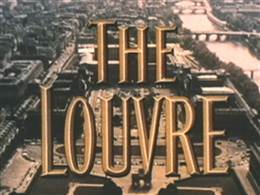
My husband recently bought a Roku unit because we want to eliminate cable from our budget soon, but want to be able to view EWTN. He found a channel with old movies and documentaries, including a 1963 film about the Louvre Museum, hosted by Charles Boyer, and produced and directed by Lucy Jarvis. This is of course, the Louvre long before the I.M. Pei glass pyramid. It's in the days when ladies wore hats and gentlemen did too, but took them off while indoors (unlike fellows wearing their baseball caps at the table in restaurants now!--and now I sound persnickety and old-fashioned and I guess I am). You can see a sample of the film here.
The film is old, of course, although when I told a friend that (she was born in 1963) it raised some hackles. I meant that the quality of the copy we saw was a little on the jaundiced side. And I told her think how old it would be if made in 1958!
The version on the Roku station was a rebroadcast by NBC News, introduced by Edwin R. Newman with comments from Lucy Jarvis. Newman died in 2010, but I think that Jarvis is still alive. She was a great trailblazer for women in television production, according to The Paley Center for Media. Lucy Jarvis talks about making the film here. She also produced films about the National Gallery in Washington, DC, and the Kremlin.
Of course, watching this has just inspired me to plan another trip to Paris next year. We are looking at dates in March and thinking about renting an apartment for a week. And perhaps I'll finally get my husband INSIDE the Louvre, "The Golden Prison".
Published on September 07, 2013 23:00
Birth of the Blessed Virgin Mary
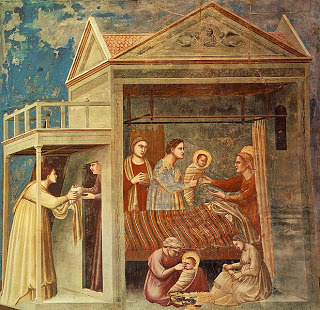
On the 1962 Missal liturgical calendar, today we celebrate the Feast of the Nativity of the Blessed Virgin Mary along with the Sixteenth Sunday after Pentecost. As this article from EWTN's library notes:
The origin of this Feast is sought in Palestine. It goes back to the consecration of a church in Jerusalem, which tradition identifies as that of the present basilica of St. Ann.
At Rome the Feast began to be kept toward the end of the 7th century, brought there by Eastern monks. Gradually and in varied ways it spread to the other parts of the West in the centuries that followed. From the 13th century on, the celebration assumed notable importance, becoming a Solemnity with a major Octave and preceded by a Vigil calling for a fast. The Octave was reduced to a simple one during the reform of St. Pius X and was abolished altogether under the reform of Pius XII in 1955.
The present Calendar characterizes the Birth of Mary as a "Feast," placing it on the same plane as the Visitation.
For some centuries now, the Birth has been assigned to September 8 both in the East and in the West, but in ancient times it was celebrated on different dates from place to place. However, when the Feast of the Immaculate Conception (which has a later origin than that of the Birth) was extended to the whole Church, the Birth little by little became assigned everywhere to September 8: nine months after the Solemnity of the Immaculate Conception.
A poem on the Nativity of the Blessed Virgin Mary by St. Robert Southwell:
Joye in the risinge of our orient starr,
That shall bringe forth the Sunne that lent her light;
Joy in the peace that shall conclude our warr,
And soone rebate the edge of Satan's spight;
Load-starr of all engolfd in worldly waves,
The card and compasse that from shipwracke saves.
The patriark and prophettes were the floures
Which Tyme by course of ages did distill,
And culld into this little cloude the shoures
Whose gracious droppes the world with joy shall fill;
Whose moysture suppleth every soule with grace,
And bringeth life to Adam's dyinge race.
For God, on Earth, she is the royall throne,
The chosen cloth to make His mortall weede;
The quarry to cutt out our Corner-stone,
Soyle full of fruite, yet free from mortall seede;
For heavenly floure she is the Jesse rodd
The childe of man, the parent of God.
Carcanet Press published The Collected Poems of Robert Southwell, SJ in 2007:
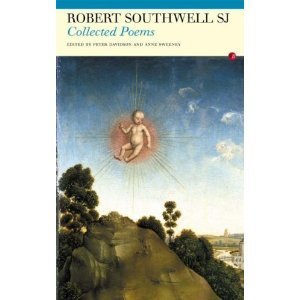 INCLUDES AN INTRODUCTION AND AFTERWORD BY ANN SWEENEY AND AN ESSAY BY PETER DAVIDSON
INCLUDES AN INTRODUCTION AND AFTERWORD BY ANN SWEENEY AND AN ESSAY BY PETER DAVIDSONOne of our earliest English critics, Ben Jonson, famously wished that he had written Southwell's 'Burning Babe', the most famous poem of the body of spiritual verse written by the Elizabethan priest, poet and martyr S. Robert Southwell SJ (1561-95). This book is a complete, authentic edition of Southwell's poems, in English and Latin, offering new texts based on the very manuscripts which were circulated in secret among English Catholics in the years following the poet's death. By re-examining these contemporary manuscripts, this edition allows Southwell's poems to regain some of their original purpose of communicating forbidden theologies and doctrines amongst a criminalised and near-silenced readership of secret groups. These are the poems of those Catholics who did not or could not flee the country as the Elizabethan State bore down upon their faith in the last two decades of the sixteenth century.
Audacious and beautiful in themselves, Southwell's poems were also immensely influential in the the development of early modern English literature; his new visions and visualisations bear their fruit a generation later in the works of Donne and Herbert. Southwell's rare Latin verses, available here for the first time, accompanied by a new translation, demonstrate the significant creative debt owed to him by the Augustans, even by Milton.
Here is a review of the collection.
Just a note that the celebration of Queen Elizabeth I's birthday on September 7 always upstaged this feast during the queen's reign, although the Church of England does include the Birth of the Virgin Mary on its liturgical calendar today.
Published on September 07, 2013 22:30
September 6, 2013
The English Reformation at Salisbury Cathedral
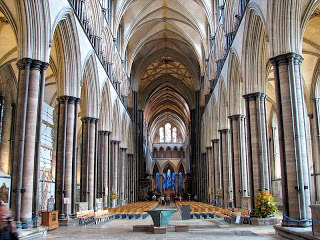
Salisbury Cathedral will host a Winter Lecture Series focused on the English Reformation and how it transformed the church in England:
Salisbury Cathedral’s Winter Lecture series, which runs from October 2013 – March 2014, focusses (sic) on the Reformation and immediate post-Reformation period when the church in England developed into a uniquely national church. The six eminent speakers will explore different aspects of what happened and why. The final lecture, which takes place in Lent, will consider Easter, looking at the Biblical authority for the festival and how the modern church will be celebrating the events of Holy Week.
The series begins on Friday 18 October with Trevor Cooper describing What happened to English parish churches after the Reformation? On Monday 18 November Giles Mandelbrote speaks on The Making of the English Bible. On Tuesday 7 January Tim Tatton-Brown discusses Salisbury Cathedral and the Reformation – the architectural changes. The lecture on Tuesday 25 February has Timothy Hone looking at Reformation Music and all who attend this lecture are invited to attend Evensong at 5.30pm during which the music will link with the lecture. The series ends on Tuesday 25 March with David Catchpole and Tom Clammer exploring Easter: the biblical tradition and the modern liturgy.
The Cathedral's news release for the series contains some great details about each lecture, for example:
Reformation Music - Timothy Hone Timothy Hone explores the changing religious positions of the sixteenth and early seventeenth centuries, and considers the musical developments which occurred, not just in the context of the Chapel Royal, but to see what might have happened in the provincial cathedrals and at Salisbury in particular. We will see how two extreme positions, during the reigns of Edward VI and Mary, found a balance during the reign of Elizabeth I. In particular, we will look at the music of Tallis and Byrd whose compositions reveal a conflict between their public music for the Anglican rite and their own private faith, revealed in much of their music with Latin texts.
Timothy Hone came to the Department of Liturgy and Music at the Cathedral after 25 years as a Cathedral musician. His interest in the relationship between music and liturgy began as an undergraduate when his dissertation on the Laudian revival at Peterhouse, Cambridge (where he was Organ Scholar) was awarded the William Barclay Squire Prize. He uses insights from his practical experience to put research into context, combining insights from a number of academic approaches.
The first speaker, Trevor Cooper, is with an organization looking at the past, present, and future of churches in England, including concerns about how historic Anglican churches (many of which were once Catholic churches) can be maintained as congregations decline.
This looks like a fascinating series. The lecture I chose to highlight would be my choice to attend, with Choral Evensong of Tallis and Byrd selections.
Image credit: wikipedia commons.
Published on September 06, 2013 04:39
September 2, 2013
Book Review: Newman and Italy
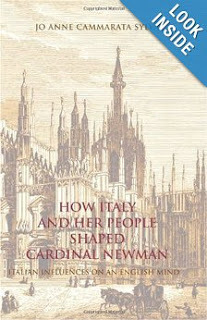
I'm sorry that I have not posted since August 31, but we've had some laptop issues and things are working better now. I just finished the book I'd assigned myself last week: How Italy and Her People Shaped Cardinal Newman: Italian Influences on an English Mind by Jo Anne Cammarata Sylva, and here's my review:
As the book's introduction promises, the narrative of Newman's trips to Rome and Italy recounts the influences travel to Italy and interaction with various Italians (living and dead) had upon Blessed John Henry Newman's understanding of teaching authority and Tradition in the Catholic Church. His first trip to Italy took place before he launched on the great journey of the Oxford Movement. When he travelled with Richard Hurrell Froude he was anti-Catholic and much that he saw shocked him: his impressions of Catholics there coincided with his views of their religion as superstitious and unreasonable. But when he became so ill in Sicily and his Italian guide and assistant, Gennaro, nursed and aided him so much in his sickness and his recovery, Newman began to see another side of Catholicism in Italy, as he experienced charity in action.
Professor Sylva also demonstrates Italian influences of a kind on Newman as he was in the throes of the Oxford Movement, investigating the history of Tradition in the teaching of the Catholic Church during the early centuries of Church history--the Arian heresy. Studying the Church Fathers, trying to establish the Via Media of the Church of England in an unbroken line from the early centuries to the Anglican Church of the nineteenth century, Newman was even influenced by reading St. Aphonsus Liquori.
In the chapter recounting Blessed Dominic Barberi's influence on Newman's conversion to Catholicism, Sylva begins the analysis of Newman's relationships with living Italians. The Passionist missionary gave Newman the first glimpse of Catholic priestly holiness. Although he was in correspondence with a priest in Ireland, Father Charles Russell, most of his investigation of the Catholic Church as the one, holy, catholic and apostolic Church was in books and in history: with Father Dominic, he began to see the holiness of life he sought in the True Church--and thus, Barberi received Newman into the Catholic Church at Littlemore on October 9, 1845.
Newman and his great friend Ambrose St. John then went to Rome to study for the priesthood in 1846, and Sylva describes the influences of three Italians active in religious and literary life at the time: Alessandro Manzoni, the historical novelist (Il Promessi Sposi/The Betrothed); Father Antonio Rosmini, founder of the Institute of Charity, and Father Giovanni Perrone, SJ, who guided Newman into a better understanding of his own theory of the development of doctrine. The curious thing about Newman's connections to the first two men is that he never met them--in spite of trying to catch up with them in Milan or Rome, the meetings never took place--and indeed it seems that Rosmini did not want to meet Newman.
Finally, of course, there is the great influence of St. Philip Neri on Newman's vocation as an Oratorian, and the spiritual guidance of the Oratory's founder in Newman's life. Newman's vision of the Oratory Movement in England of course, hit some rough patches, and he and Ambrose St. John returned to Italy and to Rome in 1856 to clear the course. They met with other Oratorians in northern Italy (Turin and Verona) and then had an audience with Pope Pius IX--all in the cause of establishing the independence of one Oratory from another, when Father Faber's London Oratory suggested that Newman's Birmingham Oratory should conform to the former's new mission of providing spiritual directions to religious communities. That third trip to Rome satisfied Newman's goals and he returned to England more secure in his relationship to Pope Pius IX.
The next pope, Leo XIII, would make Newman a Cardinal Deacon and allow him to remain in England as an Oratorian--not to take up residence in Rome at his titular church, St. Gregorio in Velabro--as an exception to the usual rule. Newman did travel to Rome to receive the red hat, but he was ill and could not receive friends and admirers as he hoped.
Professor Sylva drives this narrative of Italian influences on Blessed John Henry Newman forward with many quotations from Newman's letters and secondary sources, sometimes quoting long passages from biographies or other studies. The bibliography contains a long list of primary and secondary sources, representing the standard studies of Newman's life and works; all of the primary sources are published works (no archival sources), and there is no index, which is regrettable.
Published on September 02, 2013 22:30
August 30, 2013
Dawson on Victiorians and Catholicism
After posting on the History Today book review yesterday, I found this essay by Christopher Dawson on ENGLISH CATHOLICISM AND VICTORIAN LIBERALISM in the EWTN Library:
The hundred years that have elapsed since the restoration of the English Hierarchy [in 1850] have been a time of slow but uninterrupted progress for English Catholicism [Dawson thus was writing in 1950]. There have been no spectacular triumphs and no catastrophic defeats, but step by step the Church has been gradually recovering her lost position in the life of the nation. And this is no small achievement when one considers how completely the face of the world has changed during the last century: how the old European order and the new liberal order that aspired to take its place have both alike been swept away by new forces that were hardly perceptible in 1850, so that Europe itself and the millennial tradition of Western civilization are now in process of dissolution.
In 1850 English Liberalism, having surmounted the crisis of Chartism, was settling down to enjoy the fruits of the new order that it had created. The collapse of the old regime on the Continent in 1848 and the failure of the revolutionary movements to establish a stable democratic order had combined to strengthen the prestige of English institutions and ideals, not only in our own eyes but in those of Europe. Consequently, it is not surprising that the restoration of the Hierarchy and the reappearance of Catholicism as a living power in nineteenth-century England should have been regarded as a challenge to the spirit of the age, an act of "papal aggression." For the liberal rationalist and the conservative Protestant alike, the Papacy seemed the embodiment of those forces of reaction against which the modern world was in revolt.
The Great Exhibition of 1851 marked the final achievement of the Victorian compromise in which all the leading elements of English society found their place. High Tories like the Duke of Wellington, cosmopolitan pacifists like John Bright, Christian idealists and scientific rationalists, artisans and capitalists, all came together under the leadership of the Queen and the Prince Consort to celebrate the triumphs of science and industry and the dawn of a new era of universal peace and enlightenment. But there was no place for the English Catholics in this festival of national and international unity. The unpopularity of the Oxford conversions combined with that of Irish Nationalism and that of the Papal Government caused Catholics to be regarded with hostility and suspicion by Liberals and Conservatives alike. In their attitude to Catholicism there was nothing to choose between Liberals like Lord John Russell and Tory extremists of the type of Newdegate and Sir Robert Inglis.
Yet in spite of all this, the deeper intellectual tendencies of the age were far less hostile to Catholicism than one would suppose from the expression of popular opinion in Press and parliament. The great writers of the Victorian age, such as Carlyle and Ruskin and Matthew Arnold, were as a rule highly critical of the optimism and selfcomplacency of Victorian liberalism.
Dawson goes on to cite cultural influences like the Romantic and Victorian interest in the Middle Ages, and of course the rise of Catholic intellectual converts like Newman and Manning.
But even as he comments on this rise and influence of Catholics in English Society, Dawson notes that it proceeded along the lines of Victorian liberalism and secularization:
Yet throughout this period the secularization of English culture has proceeded almost without a check, so that our position today is no longer that of a Catholic minority in a Protestant society, but that of a religious minority in a secular or neo-pagan civilization. We have become so accustomed to this change that we are apt to forget its tremendous implications. During the last hundred years English Catholicism has developed under the protection ofthe Victorian compromise. We have accepted the Victorian principles of individual freedom, religious toleration and the limited character of the State as elementary conditions of existence which hardly needed to be defended. But, in proportion as civilization becomes secularized, all these principles and rights lose their political expression in totalitarian States.
Dawson's argument reminds me of Russell Shaw's American Church and recalls Owen Chadwick's classic study of the rise of secularism in the nineteenth century. The Catholic Church in both the United States and in Britain accepted the values of the modern democratic state as the means of increasing influence and effectiveness. The great pitfall of this process is that those values wane as secularism waxes:
Today all the basic liberties which were formerly regarded as essential conditions of modern civilization are everywhere questioned and often completely abolished, and the new secularist ideologies are establishing themselves as exclusive dogmatic anti-religions which demand the total surrender of the mind and will. It is true that this country is still relatively immune. A feeble gas-jet of freedom still flickers in the dilapidated Victorian basement. But it is obvious that English Catholicism cannot rely on the continuance of the conditions which prevailed during the first century of its restored existence. Sooner or later it must come up against the same forces that prevail in the rest of the world. No doubt this will involve great changes in our apologetic, which, like so much else, is an inheritance from the Victorian age, and which has been dominated for a century by the long- drawn-out controversy with Anglicanism. Today these familiar controversies are overshadowed by the world debate between Christianity and atheism, and we have to deal not with the validity of Anglican orders but with the existence of the human soul and the ultimate foundations of the moral order.
The ever prophetic Christoper Dawson!!
The hundred years that have elapsed since the restoration of the English Hierarchy [in 1850] have been a time of slow but uninterrupted progress for English Catholicism [Dawson thus was writing in 1950]. There have been no spectacular triumphs and no catastrophic defeats, but step by step the Church has been gradually recovering her lost position in the life of the nation. And this is no small achievement when one considers how completely the face of the world has changed during the last century: how the old European order and the new liberal order that aspired to take its place have both alike been swept away by new forces that were hardly perceptible in 1850, so that Europe itself and the millennial tradition of Western civilization are now in process of dissolution.
In 1850 English Liberalism, having surmounted the crisis of Chartism, was settling down to enjoy the fruits of the new order that it had created. The collapse of the old regime on the Continent in 1848 and the failure of the revolutionary movements to establish a stable democratic order had combined to strengthen the prestige of English institutions and ideals, not only in our own eyes but in those of Europe. Consequently, it is not surprising that the restoration of the Hierarchy and the reappearance of Catholicism as a living power in nineteenth-century England should have been regarded as a challenge to the spirit of the age, an act of "papal aggression." For the liberal rationalist and the conservative Protestant alike, the Papacy seemed the embodiment of those forces of reaction against which the modern world was in revolt.
The Great Exhibition of 1851 marked the final achievement of the Victorian compromise in which all the leading elements of English society found their place. High Tories like the Duke of Wellington, cosmopolitan pacifists like John Bright, Christian idealists and scientific rationalists, artisans and capitalists, all came together under the leadership of the Queen and the Prince Consort to celebrate the triumphs of science and industry and the dawn of a new era of universal peace and enlightenment. But there was no place for the English Catholics in this festival of national and international unity. The unpopularity of the Oxford conversions combined with that of Irish Nationalism and that of the Papal Government caused Catholics to be regarded with hostility and suspicion by Liberals and Conservatives alike. In their attitude to Catholicism there was nothing to choose between Liberals like Lord John Russell and Tory extremists of the type of Newdegate and Sir Robert Inglis.
Yet in spite of all this, the deeper intellectual tendencies of the age were far less hostile to Catholicism than one would suppose from the expression of popular opinion in Press and parliament. The great writers of the Victorian age, such as Carlyle and Ruskin and Matthew Arnold, were as a rule highly critical of the optimism and selfcomplacency of Victorian liberalism.
Dawson goes on to cite cultural influences like the Romantic and Victorian interest in the Middle Ages, and of course the rise of Catholic intellectual converts like Newman and Manning.
But even as he comments on this rise and influence of Catholics in English Society, Dawson notes that it proceeded along the lines of Victorian liberalism and secularization:
Yet throughout this period the secularization of English culture has proceeded almost without a check, so that our position today is no longer that of a Catholic minority in a Protestant society, but that of a religious minority in a secular or neo-pagan civilization. We have become so accustomed to this change that we are apt to forget its tremendous implications. During the last hundred years English Catholicism has developed under the protection ofthe Victorian compromise. We have accepted the Victorian principles of individual freedom, religious toleration and the limited character of the State as elementary conditions of existence which hardly needed to be defended. But, in proportion as civilization becomes secularized, all these principles and rights lose their political expression in totalitarian States.
Dawson's argument reminds me of Russell Shaw's American Church and recalls Owen Chadwick's classic study of the rise of secularism in the nineteenth century. The Catholic Church in both the United States and in Britain accepted the values of the modern democratic state as the means of increasing influence and effectiveness. The great pitfall of this process is that those values wane as secularism waxes:
Today all the basic liberties which were formerly regarded as essential conditions of modern civilization are everywhere questioned and often completely abolished, and the new secularist ideologies are establishing themselves as exclusive dogmatic anti-religions which demand the total surrender of the mind and will. It is true that this country is still relatively immune. A feeble gas-jet of freedom still flickers in the dilapidated Victorian basement. But it is obvious that English Catholicism cannot rely on the continuance of the conditions which prevailed during the first century of its restored existence. Sooner or later it must come up against the same forces that prevail in the rest of the world. No doubt this will involve great changes in our apologetic, which, like so much else, is an inheritance from the Victorian age, and which has been dominated for a century by the long- drawn-out controversy with Anglicanism. Today these familiar controversies are overshadowed by the world debate between Christianity and atheism, and we have to deal not with the validity of Anglican orders but with the existence of the human soul and the ultimate foundations of the moral order.
The ever prophetic Christoper Dawson!!
Published on August 30, 2013 23:00
August 29, 2013
Meta-Meta-Meta History: Current Views of Victorian Views of English History
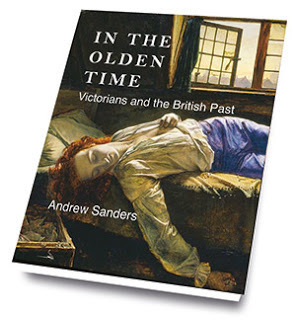 History Today
features this review of a book looking at how the Victorians looked at English history; thus it's a meta-meta-meta history. Our view of how the Victorians interpreted English history:
History Today
features this review of a book looking at how the Victorians looked at English history; thus it's a meta-meta-meta history. Our view of how the Victorians interpreted English history:Victorians saw themselves as moral and progressive. They frequently referred to the brutal history that had preceded them. The more benighted the past, the better they seemed. Thus, as Andrew Sanders explains, a great deal of British history before the 18th century was popularly characterised as being ‘little more than a series of judicial executions and violent or untimely deaths. The sad stories of the death of kings were retold with relish and the sword, the axe, the assassin’s dagger and the poisoned cup became a stock in trade of history painting’.
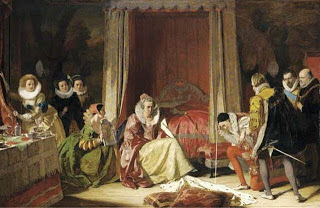
The beautifully titled painting Queen Elizabeth Discovers She is No Longer Young by Augustus Egg is typical of the way Elizabeth, with her capricious ways and refusal to do the womanly thing, to marry and procreate, was contrasted with the Victorians’ own dear queen. The 1848 picture shows a haggard, hook-nosed Elizabeth grumpily averting her eyes from a looking-glass in front of a group of fawning courtiers.
In contrast Queen Victoria holds Prince Arthur in her plump arms to receive a jewelled box from the elderly hero, the Duke of Wellington, while that symbol of magnificence, the Crystal Palace, glimmers in the distance in Franz Xaver Winterhalter’s painting The First of May 1851.
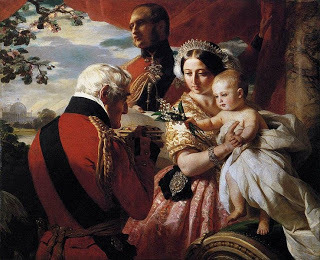
Sanders, a Dickens expert and emeritus professor of English at Durham, builds on the work of Roy Strong’s And When Did You Last See Your Father? The Victorian Painter and British History (1978). Sanders’ contribution is to explore the literary nature of Victorian history to reveal how painters were indebted to written record. Literary figures, moreover, not only wrote that record, they became part of it. In the 1840s Thomas Carlyle had identified the literary man as a new breed of hero. Henry Wallis’ 1856 painting of the teenaged suicide Thomas Chatterton was a new kind of history painting. Saunders suggests the image represented to the Victorians both the 18th-century’s neglect of the man of letters and, correspondingly, their own enlightened approach, as they were prepared to commemorate him.
Jad Adams does not mention in his review how Sanders recounts the Victorian view of the English Reformation, but according to the publisher, Yale University Press, Sanders focuses on Pugin and Cobbett:
In this richly textured and wide-ranging survey of Victorian attitudes to the past, Andrew Sanders builds on Roy Strong’s groundbreaking book And when did you last see your father?: The Victorian Painter and British History (1978). Sanders explores the essentially literary nature of Victorian history writing, and he reveals the degree to which painters were indebted to written records both fictional and factual. Starting with a stimulating comparison of Queens Elizabeth I and Victoria, In the Olden Time examines works by poets and painters, essayists and dramatists, architects and musicians, including Jane Austen, John Donne, William Shakespeare, and John Soane. Together with a study of religious history as seen through the eyes of architect and critic Augustus Pugin and journalist William Cobbett, this book offers an original view of Victorian responses to British history, presenting a fresh investigation of unexpected Victorian attitudes and the establishment of particular 20th-century prejudices and bias.
I would think that James Anthony Froude would be represented as the mainstream of Victorian attitudes to the English Reformation in historical prose, but Sanders' emphasis on historical views of the past seen through the arts and literature looks as fascinating as an examination of Victorian historiography would be--perhaps even more so. The whole genre of historical painting appears to be a great subject for exploration. Think of the effect of Delarouche's painting of Lady Jane Grey on the scaffold and how it influenced the common views of her as an innocent victim and object of pity.
Published on August 29, 2013 22:30
August 28, 2013
Blessed Richard Hurst, Executed on the Feast of the Beheading of St. John the Baptist
This martyr, a farmer with a family, was a public recusant in Lancashire. He was executed on August 29 in 1628 after a rigged trial.
According to this blog:
A CONVICTED recusant, he was ploughing his field when one Dewhurst came to serve him with a warrant. Herst fled, and Dewhurst, following in pursuit, received a blow from Herst's maid, and afterwards in the heat of the pursuit fell and broke his leg. From that wound in the leg he died, yet Herst, who had never been within thirty yards of him, was charged with his death. Herst's pardon was offered him if he would take the oath, but he refused, and he declined also to go to church, so he was trailed there by his legs and much hurt. In the church he stopped his ears, not to hear false doctrine, and, on returning, said, "They have tortured my body, but, thank God, they have not hurt my soul." At his trial at Lancaster, though his innocence of Dewhurst's death was evident, the judge told the jury that he was a recusant, had resisted the Bishop's authority, and that they must find it murder for an example, which was done. At the gallows he said to the hangman, who was bungling with the rope, "Tom, I think I must come and help you." Then, after repeating the holy names of Jesus and Mary, he passed to immortality, Lancaster, August 29.
He corresponded with his confessor while in prison awaiting his execution:
THIS is his last letter to his confessor when about to suffer : "Now I take my last leave; now I am dying, and am as willing to die as ever I was to live, I thank my Lord and Saviour, who I trust will never fail me. I have comfort in Christ Jesus and His Blessed Mother, my good angel, and all the blessed Saints, and in the valiant and triumphant martyr, B. Arrowsmith, who is gone before me. How I have been used you will hear, and likewise what I had offered me if I would have taken the oath. I hope my friends will truly understand that my greatest desire is to suffer, and I would I had as many lives to offer as I have committed sins. Now, dear Sir, prepare yourself also to suffer, and animate your ghostly children in suffering. Once again, I desire you to say and to procure some Masses for my sinful soul, and if it please God to receive me into His kingdom, I shall not be unmindful of you and of all my good friends. I pray you remember my poor children, and encourage my friends about my debts which my chief worldly care is to satisfy. Once again, adieu. I desire to be dissolved, and to be with Christ Jesus."
The B. Arrowsmith he refers to is, of course, St. Edmund (Bryan) Arrowsmith, SJ who had been executed the day before.
According to this blog, Blessed Richard Hurst reflected on the martyrdom of St. John the Baptist before his execution:
He kissed the gallows on reaching the place of execution, and disregarding the ministers present, recommended himself to God, and begged the prayers of the Blessed Virgin, his angel guardian, and all the saints, especially St. John the Baptist, it being the day of his decollation. Ascending the ladder, he repeated the names of Jesus and Mary, and so was put to death.
More on the Lancashire Martyrs here.
According to this blog:
A CONVICTED recusant, he was ploughing his field when one Dewhurst came to serve him with a warrant. Herst fled, and Dewhurst, following in pursuit, received a blow from Herst's maid, and afterwards in the heat of the pursuit fell and broke his leg. From that wound in the leg he died, yet Herst, who had never been within thirty yards of him, was charged with his death. Herst's pardon was offered him if he would take the oath, but he refused, and he declined also to go to church, so he was trailed there by his legs and much hurt. In the church he stopped his ears, not to hear false doctrine, and, on returning, said, "They have tortured my body, but, thank God, they have not hurt my soul." At his trial at Lancaster, though his innocence of Dewhurst's death was evident, the judge told the jury that he was a recusant, had resisted the Bishop's authority, and that they must find it murder for an example, which was done. At the gallows he said to the hangman, who was bungling with the rope, "Tom, I think I must come and help you." Then, after repeating the holy names of Jesus and Mary, he passed to immortality, Lancaster, August 29.
He corresponded with his confessor while in prison awaiting his execution:
THIS is his last letter to his confessor when about to suffer : "Now I take my last leave; now I am dying, and am as willing to die as ever I was to live, I thank my Lord and Saviour, who I trust will never fail me. I have comfort in Christ Jesus and His Blessed Mother, my good angel, and all the blessed Saints, and in the valiant and triumphant martyr, B. Arrowsmith, who is gone before me. How I have been used you will hear, and likewise what I had offered me if I would have taken the oath. I hope my friends will truly understand that my greatest desire is to suffer, and I would I had as many lives to offer as I have committed sins. Now, dear Sir, prepare yourself also to suffer, and animate your ghostly children in suffering. Once again, I desire you to say and to procure some Masses for my sinful soul, and if it please God to receive me into His kingdom, I shall not be unmindful of you and of all my good friends. I pray you remember my poor children, and encourage my friends about my debts which my chief worldly care is to satisfy. Once again, adieu. I desire to be dissolved, and to be with Christ Jesus."
The B. Arrowsmith he refers to is, of course, St. Edmund (Bryan) Arrowsmith, SJ who had been executed the day before.
According to this blog, Blessed Richard Hurst reflected on the martyrdom of St. John the Baptist before his execution:
He kissed the gallows on reaching the place of execution, and disregarding the ministers present, recommended himself to God, and begged the prayers of the Blessed Virgin, his angel guardian, and all the saints, especially St. John the Baptist, it being the day of his decollation. Ascending the ladder, he repeated the names of Jesus and Mary, and so was put to death.
More on the Lancashire Martyrs here.
Published on August 28, 2013 22:30
August 27, 2013
George Sand, Chopin, and St. Augustine and St. Monica
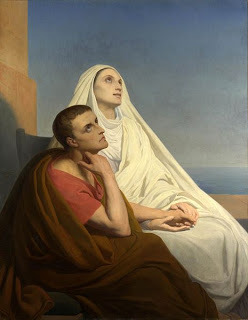
On a previous visit to Paris, I visited the Nouvelle Athenes area, starting with Église de la Sainte-Trinité in the 9th arrondisement, La Musee de la vie romantique, and the Passages or walk through shopping streets near Boulevard Montmartre.
When I entered Sainte-Trinite (Holy Trinity), the Blessed Sacrament was exposed on the Altar in huge monstrance with a sun burst design. I was there just in time for Benediction, and the priest struggled mightily to make the Sign of the Cross and bless us. The park in front the church was quiet that morning, but when I took my husband to see Sainte-Trinite later one day, the lawns were covered with picnickers and others relaxing--just before a sudden rain storm. Then everyone dispersed and we ran over to the metro across the street for our next stop.
But during my tour, I left Sainte-Trinite in search of La Musee de la vie romantique, quite a way off the tourist route, and arrived before it opened. So I walked a little further down Rue Chaptal to find a tabac or brasserie for a cup of coffee.
La Musee de la vie romantique combines memories of George Sand and Frederic Chopin and the works of Ary Sheffer--and thus the connection to St. Augustine, whose feast we celebrate today, and his mother, St. Monica, whose feast we celebrated yesterday through the painting depicted above. The painting shows the two saints in that ecstasy St. Augustine describes in the tenth chapter of book nine in the Confesssions :
23. As the day now approached on which she was to depart this life -- a day which thou knewest, but which we did not -- it happened (though I believe it was by thy secret ways arranged) that she and I stood alone, leaning in a certain window from which the garden of the house we occupied at Ostia could be seen. Here in this place, removed from the crowd, we were resting ourselves for the voyage after the fatigues of a long journey.
We were conversing alone very pleasantly and "forgetting those things which are past, and reaching forward toward those things which are future."[293] We were in the present -- and in the presence of Truth (which thou art) -- discussing together what is the nature of the eternal life of the saints: which eye has not seen, nor ear heard, neither has entered into the heart of man.[294] We opened wide the mouth of our heart, thirsting for those supernal streams of thy fountain, "the fountain of life" which is with thee,[295] that we might be sprinkled with its waters according to our capacity and might in some measure weigh the truth of so profound a mystery.
24. And when our conversation had brought us to the point where the very highest of physical sense and the most intense illumination of physical light seemed, in comparison with the sweetness of that life to come, not worthy of comparison, nor even of mention, we lifted ourselves with a more ardent love toward the Selfsame,[296] and we gradually passed through all the levels of bodily objects, and even through the heaven itself, where the sun and moon and stars shine on the earth. Indeed, we soared higher yet by an inner musing, speaking and marveling at thy works.
And we came at last to our own minds and went beyond them, that we might climb as high as that region of unfailing plenty where thou feedest Israel forever with the food of truth, where life is that Wisdom by whom all things are made, both which have been and which are to be. Wisdom is not made, but is as she has been and forever shall be; for "to have been" and "to be hereafter" do not apply to her, but only "to be," because she is eternal and "to have been" and "to be hereafter" are not eternal.
And while we were thus speaking and straining after her, we just barely touched her with the whole effort of our hearts. Then with a sigh, leaving the first fruits of the Spirit bound to that ecstasy, we returned to the sounds of our own tongue, where the spoken word had both beginning and end.[297] But what is like to thy Word, our Lord, who remaineth in himself without becoming old, and "makes all things new"[298]?
Before visiting the Passages Jouffroy, des Panoramas, and the Galerie Vivienne, I stopped in Notre Dame de Lorette to close the triangle of Nouvelle Athenes in Paris.
Published on August 27, 2013 23:00
All the Graces of Oxford and Cambridge!
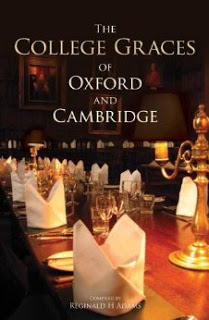
When I attended The Oxford Experience several years ago, I noticed they maintained a tradition of saying a very Christian grace before the more formal meals, with the High Table and the Final Banquet:
The Christ Church Grace
At Oxford Experience High Table Dinners and Final Dinners the shorter version of the Christ Church Latin Grace is read:
Nos, miseri homines et egeni, pro cibis, quos nobis ad corporis subsidium benigne es largitus, tibi, Deus Omnipotens, Pater Cælestis, gratias reverenter agimus; simul obsecrantes, ut iis sobrie, modeste atque grate utamur, per Jesum Christum Dominum Nostrum, Amen.
Here is the translation:
We unhappy and unworthy people do give thee most reverent thanks, almighty God, our heavenly Father, for the victuals which thou hast bestowed on us for the sustenance of the body, at the same time beseeching thee that we may use them soberly, modestly and gratefully. Through Jesus Christ our Lord, Amen.
This even though the participants had many different--or no--faith backgrounds.
The full grace of Christ Church is surely in this book:
The custom of formal dining at Oxford and Cambridge dates back to the earliest days of college life. Before each dinner, according to ancient statutes, grace must be said in Latin, and, although the text and nature of grace for each college has changed over the years, the tradition itself remains current to this day.
Following a historical introduction, The College Graces of Oxford and Cambridge reproduces in chronological order the full Latin texts of all the graces alongside facing English-language translations. Also included are the special graces reserved for feast days, as well as an explanation of some of the traditions that accompany them, including the trumpeters that summon students to dinner to the use of the Sconce Cup and the Rose Bowl.
From the twelfth-century monastic texts and the two-word graces of the nineteenth century to the new graces written for the modern age, this meticulous collection reveals how the tradition of the Latin grace has survived and evolved over the centuries and offers a rare glimpse inside the private halls of Oxford and Cambridge.
The University of Chicago Press is distributing the book for the Bodleian Library.
Of course, one reason such a prayer before meals creates no opposition is that no one knows what the Latin means! Queens College at Cambridge provides a special page just for those students who don't know Latin. However, in 2009, one college at Cambridge gave up its tradition of Latin grace, according to this story in The Telegraph.
Published on August 27, 2013 22:30



